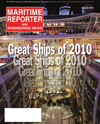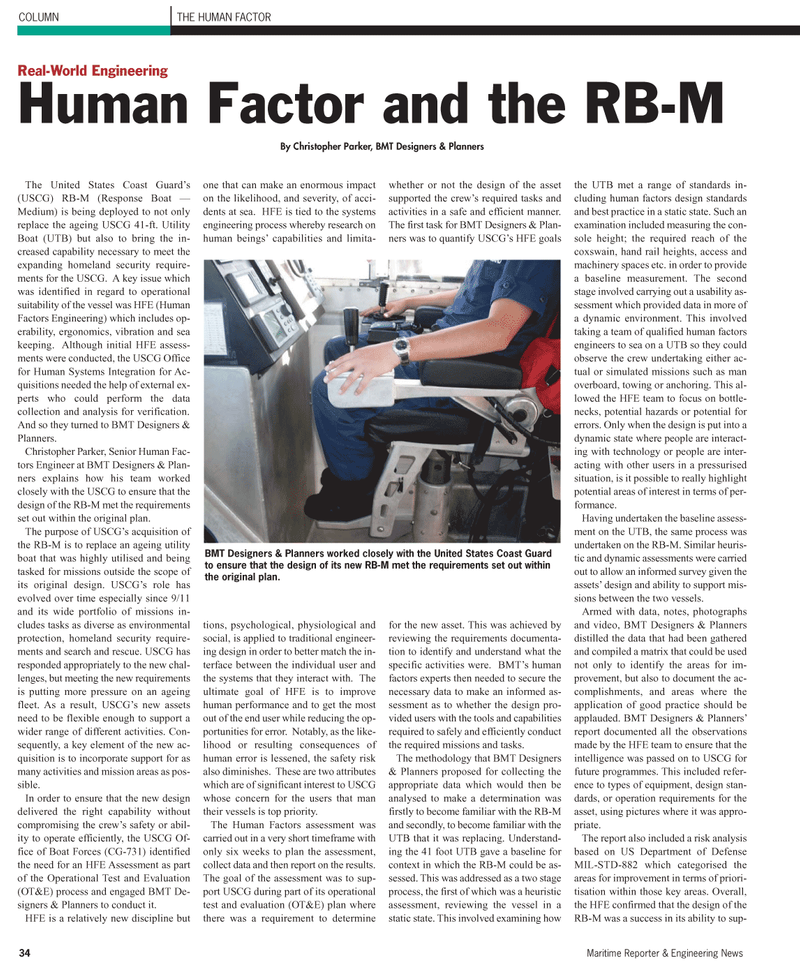
Page 34: of Maritime Reporter Magazine (December 2010)
Great Ships of 2010
Read this page in Pdf, Flash or Html5 edition of December 2010 Maritime Reporter Magazine
34 Maritime Reporter & Engineering News
The United States Coast Guard’s (USCG) RB-M (Response Boat —
Medium) is being deployed to not only replace the ageing USCG 41-ft. Utility
Boat (UTB) but also to bring the in- creased capability necessary to meet the expanding homeland security require- ments for the USCG. A key issue which was identified in regard to operational suitability of the vessel was HFE (Human
Factors Engineering) which includes op- erability, ergonomics, vibration and sea keeping. Although initial HFE assess- ments were conducted, the USCG Office for Human Systems Integration for Ac- quisitions needed the help of external ex- perts who could perform the data collection and analysis for verification.
And so they turned to BMT Designers &
Planners.
Christopher Parker, Senior Human Fac- tors Engineer at BMT Designers & Plan- ners explains how his team worked closely with the USCG to ensure that the design of the RB-M met the requirements set out within the original plan.
The purpose of USCG’s acquisition of the RB-M is to replace an ageing utility boat that was highly utilised and being tasked for missions outside the scope of its original design. USCG’s role has evolved over time especially since 9/11 and its wide portfolio of missions in- cludes tasks as diverse as environmental protection, homeland security require- ments and search and rescue. USCG has responded appropriately to the new chal- lenges, but meeting the new requirements is putting more pressure on an ageing fleet. As a result, USCG’s new assets need to be flexible enough to support a wider range of different activities. Con- sequently, a key element of the new ac- quisition is to incorporate support for as many activities and mission areas as pos- sible.
In order to ensure that the new design delivered the right capability without compromising the crew’s safety or abil- ity to operate efficiently, the USCG Of- fice of Boat Forces (CG-731) identified the need for an HFE Assessment as part of the Operational Test and Evaluation (OT&E) process and engaged BMT De- signers & Planners to conduct it.
HFE is a relatively new discipline but one that can make an enormous impact on the likelihood, and severity, of acci- dents at sea. HFE is tied to the systems engineering process whereby research on human beings’ capabilities and limita- tions, psychological, physiological and social, is applied to traditional engineer- ing design in order to better match the in- terface between the individual user and the systems that they interact with. The ultimate goal of HFE is to improve human performance and to get the most out of the end user while reducing the op- portunities for error. Notably, as the like- lihood or resulting consequences of human error is lessened, the safety risk also diminishes. These are two attributes which are of significant interest to USCG whose concern for the users that man their vessels is top priority.
The Human Factors assessment was carried out in a very short timeframe with only six weeks to plan the assessment, collect data and then report on the results.
The goal of the assessment was to sup- port USCG during part of its operational test and evaluation (OT&E) plan where there was a requirement to determine whether or not the design of the asset supported the crew’s required tasks and activities in a safe and efficient manner.
The first task for BMT Designers & Plan- ners was to quantify USCG’s HFE goals for the new asset. This was achieved by reviewing the requirements documenta- tion to identify and understand what the specific activities were. BMT’s human factors experts then needed to secure the necessary data to make an informed as- sessment as to whether the design pro- vided users with the tools and capabilities required to safely and efficiently conduct the required missions and tasks.
The methodology that BMT Designers & Planners proposed for collecting the appropriate data which would then be analysed to make a determination was firstly to become familiar with the RB-M and secondly, to become familiar with the
UTB that it was replacing. Understand- ing the 41 foot UTB gave a baseline for context in which the RB-M could be as- sessed. This was addressed as a two stage process, the first of which was a heuristic assessment, reviewing the vessel in a static state. This involved examining how the UTB met a range of standards in- cluding human factors design standards and best practice in a static state. Such an examination included measuring the con- sole height; the required reach of the coxswain, hand rail heights, access and machinery spaces etc. in order to provide a baseline measurement. The second stage involved carrying out a usability as- sessment which provided data in more of a dynamic environment. This involved taking a team of qualified human factors engineers to sea on a UTB so they could observe the crew undertaking either ac- tual or simulated missions such as man overboard, towing or anchoring. This al- lowed the HFE team to focus on bottle- necks, potential hazards or potential for errors. Only when the design is put into a dynamic state where people are interact- ing with technology or people are inter- acting with other users in a pressurised situation, is it possible to really highlight potential areas of interest in terms of per- formance.
Having undertaken the baseline assess- ment on the UTB, the same process was undertaken on the RB-M. Similar heuris- tic and dynamic assessments were carried out to allow an informed survey given the assets’ design and ability to support mis- sions between the two vessels.
Armed with data, notes, photographs and video, BMT Designers & Planners distilled the data that had been gathered and compiled a matrix that could be used not only to identify the areas for im- provement, but also to document the ac- complishments, and areas where the application of good practice should be applauded. BMT Designers & Planners’ report documented all the observations made by the HFE team to ensure that the intelligence was passed on to USCG for future programmes. This included refer- ence to types of equipment, design stan- dards, or operation requirements for the asset, using pictures where it was appro- priate.
The report also included a risk analysis based on US Department of Defense
MIL-STD-882 which categorised the areas for improvement in terms of priori- tisation within those key areas. Overall, the HFE confirmed that the design of the
RB-M was a success in its ability to sup-
COLUMN THE HUMAN FACTOR
Real-World Engineering
Human Factor and the RB-M
By Christopher Parker, BMT Designers & Planners
BMT Designers & Planners worked closely with the United States Coast Guard to ensure that the design of its new RB-M met the requirements set out within the original plan.

 33
33

 35
35
